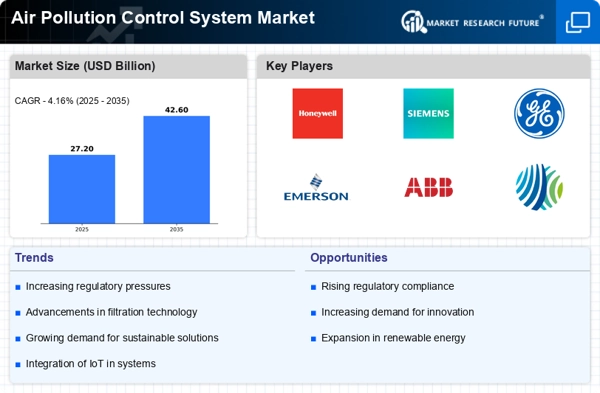Rising Public Awareness
Public awareness regarding air quality and its health implications is on the rise, significantly impacting the Air Pollution Control System Market. As communities become more informed about the dangers of air pollution, there is a growing demand for cleaner air solutions. This shift in consumer behavior is prompting industries to adopt more stringent air quality measures and invest in advanced pollution control technologies. The market is likely to benefit from this trend, with projections indicating a potential increase in demand for air pollution control systems by 10% annually as businesses strive to meet consumer expectations and enhance their corporate social responsibility initiatives.
Technological Innovations
Technological advancements play a pivotal role in shaping the Air Pollution Control System Market. Innovations such as the development of more efficient scrubbers, filters, and catalytic converters are enhancing the effectiveness of air pollution control systems. These technologies not only improve emission reduction rates but also lower operational costs for industries. The integration of artificial intelligence and IoT in monitoring systems is further revolutionizing the market, allowing for real-time data analysis and improved decision-making. As industries increasingly adopt these technologies, the market is expected to witness substantial growth, with a projected increase in market size by approximately 8% over the next five years.
Focus on Sustainable Practices
The emphasis on sustainability is reshaping the Air Pollution Control System Market. Companies are increasingly adopting sustainable practices to reduce their environmental footprint and comply with evolving regulations. This focus on sustainability is driving the demand for innovative air pollution control technologies that not only meet regulatory standards but also promote energy efficiency. Industries are investing in systems that utilize renewable energy sources and minimize waste, aligning with global sustainability goals. As a result, the market is projected to grow, with a potential increase in demand for sustainable air pollution control solutions by approximately 9% in the next few years.
Increasing Regulatory Pressure
The Air Pollution Control System Market is experiencing heightened regulatory pressure as governments worldwide implement stricter environmental regulations. This trend is driven by the need to mitigate air pollution and its adverse health effects. For instance, regulations such as the Clean Air Act in various regions mandate the reduction of emissions from industrial sources. As a result, industries are compelled to invest in advanced air pollution control technologies to comply with these regulations. The market is projected to grow significantly, with estimates suggesting a compound annual growth rate of over 6% in the coming years, as companies seek to avoid penalties and enhance their environmental compliance.
Economic Growth and Urbanization
Economic growth and urbanization are driving factors in the Air Pollution Control System Market. As economies expand, industrial activities increase, leading to higher emissions and a greater need for effective air pollution control solutions. Urban areas, characterized by dense populations and industrial activities, are particularly affected by air quality issues. Consequently, there is a pressing need for advanced air pollution control systems to manage emissions effectively. The market is anticipated to grow in tandem with urbanization trends, with estimates suggesting a market expansion of around 7% over the next few years as cities invest in infrastructure to combat air pollution.

















Leave a Comment